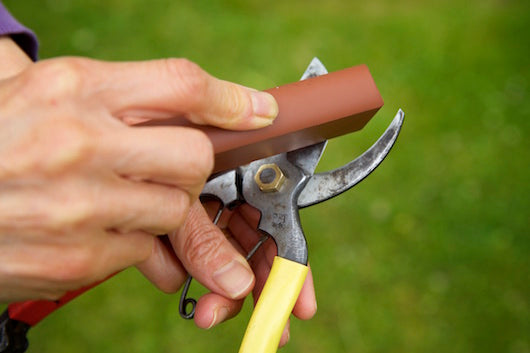Are your garden tools starting to lose their edge? Do you struggle to cut through stubborn branches or weed out those pesky plants? Well, fear not because this article will show you how to sharpen garden tools like a pro.
From pruning shears to shovels, we've got all the tips and tricks you need to bring back the sharpness and effectiveness of your trusty gardening companions. So grab a cup of coffee, put on some gloves, and get ready to transform those dull blades into cutting machines that would make Edward Scissorhands proud.
Tools Required for Sharpening Garden Tools
Sharpening your garden tools is essential to keep them in good working condition. To sharpen garden tools, you'll need the following tools and supplies:
- Safety glasses or goggles
- Heavy-duty gloves
- Wire brush or stiff-bristle brush
- A bucket of soapy water
- Mill bastard file or sharpening stone
- Honing oil or water (if using a sharpening stone)
- Sharpening guide (optional)
- Anvil or bench grinder (optional)
- Lubricating oil
- Whetstone (optional)
- Vise (optional)
- Rags or paper towels
- Paint (optional, for rust prevention)
- Blade balancer (if sharpening lawnmower blades)
Step-by-Step Guide to Sharpening Garden Tools
Sharpening your garden tools is a straightforward process essential for maintaining their effectiveness. Here's a step-by-step guide to help you sharpen your garden tools effectively:
Step 1: Safety First
Always prioritize safety. Wear safety glasses or goggles to protect your eyes, and wear heavy-duty gloves to protect your hands from sharp edges and metal shavings.
Step 2: Clean the Tools
Start by cleaning the tools to remove dirt, rust, and debris. Use a wire or stiff-bristle brush to scrub away as much dirt as possible. Soak the tools in a bucket of soapy water to remove stubborn grime and debris. This step will also make it easier to see the condition of your tools.
Step 3: Secure the Tool (Optional)
If you have a vise, you can use it to secure the tool in place. This makes the sharpening process more stable and safer.
Step 4: Inspect the Tool
Examine the tool to identify any nicks, burrs, or damaged areas that need extra attention. Mark these areas for focused sharpening.
Step 5: Choose the Sharpening Method
Decide whether you'll use a file, sharpening stone, or a bench grinder to sharpen your tool. Files and sharpening stones are better for precision, while a bench grinder can be quicker but requires more skill to avoid overheating and damaging the tool.
Step 6: Start Sharpening
Here's how to sharpen with a file or sharpening stone:
- Maintain the original bevel angle of the tool. Consult the manufacturer's guidelines for recommended angles.
- If using a file, push it away from you along the blade's edge in one direction, applying even pressure. Repeat the motion several times. If using a sharpening stone, apply honing oil or water to the stone and make circular or straight strokes.
- Continue sharpening, and checking your progress regularly. Stop when you achieve a sharp edge.
For a bench grinder:
- Hold the tool steadily against the grinder's wheel. Keep a consistent angle.
- Move the tool gently back and forth to remove the metal gradually.
- Avoid overheating the tool; dip it in water to cool if necessary.
Step 7: Hone the Edge (Optional)
You can use a finer grit sharpening stone or a whetstone to refine the edge further. Apply honing oil or water and make a few lights passes to achieve a razor-sharp edge.
Step 8: Clean the Tool
Wipe off excess oil, metal shavings, and any other debris with a rag or paper towel.
Step 9: Apply Lubricating Oil
To prevent rust, apply a light coating of lubricating oil to the tool's metal surfaces.
Step 10: Optional Steps
If desired, you can paint the metal parts to further protect against rust and store the tools in a dry place.
--> Visit KiiZYs Amazon page: houseplant tools

Benefits of Using Sharp Garden Tools
Using sharp garden tools offers several benefits, including:
Efficiency: Sharp tools cut or dig with less effort, making your gardening tasks quicker and more efficient. Sharp tools can help you complete your work quickly and with less physical strain.
Clean Cuts: Sharp blades create clean, precise cuts on plants, reducing the risk of plant damage and disease transmission. Pruning, trimming, and cutting are more effective when the tools are sharp.
Healthier Plants: Cleaning cuts with sharp tools promotes faster plant healing, reducing the risk of infection or disease. This leads to healthier, more robust plants and a more attractive garden.
Safety: Sharp tools are safer to use because they require less force, reducing the chance of slipping or losing control during use. Dull tools can lead to accidents and injuries.
Longevity of Tools: Regular sharpening extends the lifespan of your garden tools. Dull tools are more likely to become damaged and require replacement, while well-maintained, sharp tools can last for many years, saving you money in the long run.
--> Check out KiiZYs basket planters at Amazon: indoor gardening

Tips for Maintaining the Sharpness of Garden Tools
Maintaining the sharpness of garden tools is essential for efficient and safe gardening. Here are tips to help:
- Regular Sharpening: Sharpen your garden tools frequently, ideally before and after each gardening season, to maintain their sharpness.
- Cleaning: After use, clean off dirt and debris with a wire brush or soapy water. Dry them thoroughly to prevent rust.
- Proper Storage: Hang or store tools in a dry, well-ventilated area to prevent moisture accumulation and rust.
- Lubrication: Apply a thin coat of lubricating oil to metal parts to protect against rust.
- Protect Edges: Use blade guards or sheaths to protect tool edges from damage when not in use.
- Avoid Soil Contact: Minimize soil contact when using tools; excessive contact can dull blades quickly.
- Maintenance Routine: Establish a regular maintenance routine to check for damage and address it promptly to extend the life and sharpness of your garden tools.
Final Thoughts
In conclusion, keeping your garden tools sharp is essential for maintaining a healthy and productive garden. By following these simple steps – cleaning, assessing, sharpening, and protecting – you can ensure your tools are always in their best shape. Regularly inspecting and maintaining your tools will save you time and effort in the long run and prolong their lifespan. So, take the time to sharpen your garden tools and enjoy the benefits of easier digging, cutting, and pruning. Your garden will thank you!
Check out KiiZYs' Amazon Store: indoor gardening tools
FAQs
How do I know when my gardening tool needs sharpening?
If your tool struggles to cut cleanly through branches or plants, producing ragged edges instead usually indicates that it needs sharpening.
Which tools should I sharpen regularly?
Common garden tools that require regular sharpening include pruning shears, hedge trimmers, lawn mower blades, shovels, and spades.

